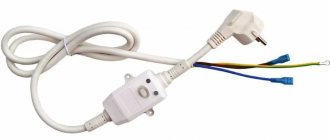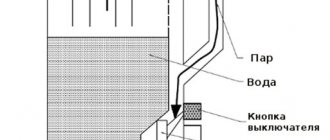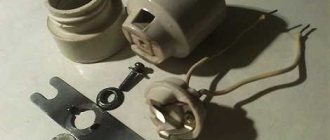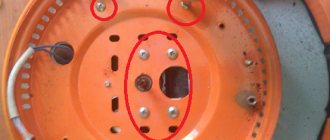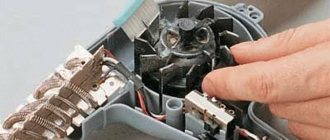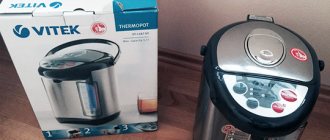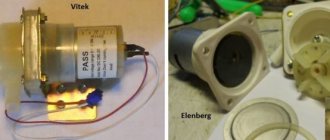Of all types of household appliances, electric kettles are most often subject to breakdowns, which is due to their intensive use and the low quality of water used for boiling. The malfunction can manifest itself in different ways: the device does not turn off on its own or, conversely, turns off prematurely, the power button sticks, the liquid does not heat up to the desired temperature. In case of minor breakdowns, it is possible to repair electric kettles on your own, but sometimes it is impossible to solve the problem without the help of a service center. In any case, you will need preliminary diagnostics of the equipment, which will allow you to determine the cause of the problem and select suitable options for eliminating it.
Principle of operation
The electric kettle is standard. Inside the removable housing there are heating elements with a power of up to 2 kW, a flask with a volume of 2–3 liters and a thermostat. Connection to the electrical network is provided by a stand with a flexible cord. The difference between individual models is manifested in the type of heating element - a stainless steel spiral or a closed disk, as well as the location of the switch (at the bottom or at the top of the handle).
The electrical circuit of teapots works on the same principle:
- mains voltage is supplied to the contacts of the stand when the cord is plugged into the outlet;
- After installing the kettle on it, the spring-loaded contacts of the stand close with the electrodes of the body;
- after turning on the power button, voltage is supplied to the disk or spiral heating element in the kettle with passage through the thermal protection elements;
- the bimetallic plate completes the circuit until the signal is received from the steam sensor.
The additional thermal protection element is optional and is not available on some models. It is introduced into the circuit to turn off the device when there is a risk of overheating and is activated only if there is no water in the device. In operating mode, the kettle's backlight should be on; when turned off, all contacts, except those spring-loaded on the stand, open.
The electric kettle does not turn on if there is no connection in any of the following areas: loose connection of the cord or stand, opening of contacts when trying to heat an empty device. In such cases, the backlight does not light up, but the device itself may be a contact device. If the kettle does not work after eliminating these reasons, the device needs diagnostics - disassembly and sequential testing of individual elements of the electrical wires.
Automation and security
All modern kettles are equipped with an automatic shut-off function when boiling and a safety lock against being turned on without water. Automatically turning off a kettle with heated water has several advantages: saving energy and, most importantly, not boiling water. According to experts, it is advisable to boil water once, especially tap water. When boiling, desalted steam comes out, and the concentration of salts in the remaining water increases.
As a rule, a modern electric kettle has a top lid with a locking lock that protects against accidental splashing of hot water. The kettle handle does not heat up from hot water.
- Electric kettle repair
- Safe kettle
Troubleshooting
The need for ringing arises when any component of the electrical circuit breaks down (the device does not turn on, the reasons are unknown, and trivial errors such as a non-working socket or loose installation have been eliminated). The work is carried out using a special device - a multimeter, as well as screwdrivers selected according to the type of screws, and a sharp knife with pliers or pliers. In this case, the following points are sequentially checked:
- The performance of the flexible cord and stand contacts. It is difficult to repair a burnt stand without the appropriate experience, and its breakdowns are visible to the naked eye, but to save time, the contact group is always checked. At this stage, one end of the tester is applied to the plug, the other to the springy contacts (most often they are located in the center). Detected faults, such as a burnt or insufficiently thick cord, carbon deposits on the surface of the brass contact, are eliminated if possible, after which the group is called again. If there are no problems on all three lines (2 current-carrying lines and ground), repairing electric kettles becomes more complicated; the body has to be disassembled.
- The performance of the heating element power supply terminals at the base of the housing. At this stage, you need to disassemble the kettle, as indicated in the instructions, and check the contacts of the outer and inner copper rings in turn. If there is no ringing, the power supply block is completely disassembled to remove carbon deposits, reassembled and checked again.
- Power button functionality. One probe of the tester touches the contact of the wire that supplies current to the button, the second touches the power wire of the heating element. The button is checked in the off and working state; if there is no sound signal about serviceability, in the second case it needs to be repaired or replaced (if necessary, power the kettle directly).
- The performance of the heating element. One probe is directed to the power contact, the second to the connection point with the wire from the power button. If the circuit breaks, you need to replace the heating element with a new one, which is not always possible.
In addition to checking the circuit with a multimeter, the actual resistance of the heating element is assessed. To perform this operation, it is enough to remove the bottom of the kettle, turn on the tester in measurement mode and point its probes at the output terminals. If there is a significant deviation from the value calculated or declared by the manufacturer, the heating element needs to be cleaned or replaced.
Check the functionality of the flexible cord and stand contacts
Check the contacts of the outer and inner copper ring
See if the power button works
Carry out diagnostics of the heating element operation
The main causes of breakdown of electric kettles
Electric kettles have a relatively simple design and, as a rule, a long service life. However, this technique can also become unusable for various reasons. We list the main reasons why you may need to repair an electric kettle.
- The formation of too thick a layer of scale inside the electric kettle, as a result of which the heating element constantly overheats and quickly fails.
- Operation of equipment without water or after it has boiled away. If there is protection against overheating, then the kettle automatically turns off in this situation, but frequent activation of the protection leads to accelerated wear of the equipment.
- Gradual oxidation of contacts and breakage of electric kettle contacts. This usually happens after prolonged use of the equipment.
After completely draining the boiled water, you should not immediately fill the electric kettle with cold water. This can lead to cracking and breakage of various elements of this equipment.
How to disassemble
This stage is considered difficult; devices from different manufacturers may have different locations of the latches holding the handle, have their own way of removing the kettle lid, and open or hidden locations of the fastening screws. To avoid mistakes, before disassembling electric kettles of a particular modification, you should carefully study the process. Some manufacturers include this information in the instructions. The general disassembly procedure includes 2 main stages:
- Removing the bottom by unscrewing the exposed screws. This design is typical for old-style teapots or fasteners covered with decorative plugs. The bottom can be removed with a simple movement or after squeezing the teeth-clamps using a flat-head screwdriver. If necessary, remove the stand cover in the same way.
- Removing the switch. Repairing kettles at this stage requires attention and patience. The function button can be located either at the top or at the bottom of the handle. To access this element, carefully remove the fragile plastic covers and turn out the internal screws, which, unlike the bottom, are almost invisible. When repairing Brown kettles and similar models with two-piece handles, the latches are snapped off along the seam; for a number of modern appliances, the upper part of the body will be removed along with the handle.
Repairing old-type kettles does not require complete disassembly of the device; heating elements and thermal protection elements open after removing several screws. Models with a switch at the top of the handle will have to be completely dismantled.
Electric kettle device
- Electric kettle stand. The design has 3 electrical contacts, two of which are located in the grooves (they are copper plates) and serve to supply voltage to the kettle, and one is located in the center and serves as a grounding conductor.
- Heating element (heating element). It can have either an open type (curved or spiral) or a closed type (like a metal disk). At the ends of the heating element there are leads for supplying voltage to them; small contacts are welded to them, onto which terminals are placed.
- Electric switch. Serves to protect and turn on an electrical appliance. There is a thermal relay installed inside that can protect the device during network overloads and overheating of electrical wires. There is a thermostat that turns off the device if the heating element overheats.
- Indicator. LED light located on the base of the kettle or on the power button. Indicates whether the electrical appliance is currently working or not.
- Frame. Mainly made of plastic, this option is available to everyone, as it is inexpensive compared to others; metal and glass (more expensive models). The stand consists of the same material as the electric kettle itself.
- Kettle flask. The cheapest and simplest models do not have it. In more expensive versions, the flask is located inside the kettle so that it does not touch its walls, which ensures that high temperatures are maintained for a long time. Consists mainly of metal or glass.
Variants of problems and ways to solve them
Possible causes of problems and solutions are given below:
| Type of problem | Possible reason | What and how to do at home |
| The kettle stopped turning on | Power button failure | The button terminals must be cleaned of carbon deposits or oxide, and the part itself must be replaced with a new one. |
| — | Contact group burnout | Replacing the plug, stripping and bending contacts |
| The kettle does not heat water, works slowly or turns off prematurely | Scale deposits on the heating element or its burnout | Cleaning/replacing the heating element |
| A kettle with boiling water does not turn off for a long time | Damage to the housing cover, thermostat, blockage of steam channels | Cleaning channels, replacing or repairing an electric thermostat |
| Water flows from the kettle | Housing leak | Attempt to replace sealing elements |
Defects such as cracks in the body or bulb, complex damage to the lid, and burnout of closed heating elements cannot be repaired. In most cases, these are the reasons for write-off that are indicated by experts’ reports when contacting service centers. If such breakdowns are discovered after the warranty period has expired, you should not rack your brains over how to repair the kettle; it is easier to replace the device with a new one.
The kettle won't turn off
Repair of kettles in such cases begins with checking the tightness of the lid and cleaning the steam supply hole to the thermostat shutdown sensor. With intensively working equipment, such channels can become clogged with scale, which can be removed with a needle or citric acid. If the cover and channels are operating normally, we disassemble and repair the thermostat. A damaged or heavily worn bimetallic strip requires replacement with a new one.
Check the tightness of the lid and clean the steam supply holes to the thermostat shutdown sensor
Disassemble and repair the thermostat
Shuts down prematurely
The main cause of this problem is scale. There is no need to send the device for write-off. To clean the heating element, folk remedies are used, for example, vinegar, citric acid, soda, poured in concentrated or diluted form overnight or brought to a boil with liquid. Modern household chemicals will also help to cope with the problem, for example, Heitmann Anti-scale liquid products, HG descaling products, Frau Schmidt or Filtero kettle tablets. If necessary, the procedure is repeated several times until the device stops turning off prematurely.
The effect of cleaning the heating element of the kettle will be short-lived if you continue to boil water with a high salt content in it. Under such operating conditions, the risk of damage to the electrical appliance increases significantly, and a heating element covered with scale may completely stop working.
Water doesn't heat up well
Complex repairs of kettles in such cases are not required; poor or slow heating of water is most often explained by scale deposits on the surface of the heating element. Its removal is carried out using the above household or chemical remedies, cleaning is repeated until the deposits are completely eliminated. In the absence of scale, poor water heating can be explained by power surges, burnt out contacts, or broken heating elements.
Specialized products (Asidol and its analogues) help speed up the repair of kettles and the process of cleaning contacts. If they are absent, the brass, copper or bronze contact is cleaned with ordinary ammonia.
In the absence of scale, poor water heating can be caused by burnout of contacts or breakdown of the heating element.
Heating element burnout
It is impossible to repair a kettle with a closed disk heater in such cases. Disc elements are integral with the bottom and are simply not available for sale. Open heating elements are changed according to a simple scheme:
- a failed heating element is removed after dismantling the fasteners;
- a new part is installed instead;
- all elements are returned to their place.
Testing the contacts helps eliminate errors and understand why the device does not work.
It is impossible to repair a kettle with a disc heater
Exposed heating element can be replaced
The button does not lock
The reason for such a breakdown of an electric kettle is most often the loss of any fixing element. Repairing the button in such cases begins with disassembling the handle, removing the fasteners and carefully inspecting the part. The whole element is simply returned to its place, but if the button is broken (the latch is damaged, the part is melted along the edges or from the inside), it is replaced with a new one. Ideally, a “native” button is installed on the kettle, but it is not always available for sale. When using a non-original part, pay attention to the correspondence of the length of the fasteners or the diameter of the holes for tightening them.
Carefully inspect the item
If damaged, the button can be replaced
How to clean an electric kettle from rust
Often, tap water, although outwardly transparent, is saturated with particles of iron oxides, simply put, rust. Over time, rust in the form of sediment begins to accumulate inside the kettle. Outwardly, it looks like the appearance of a reddish coating. Removing plaque is quite simple. To do this, just pour the maximum allowable amount of water into the kettle and add a standard sachet of citric acid. Then you need to boil this water, drain it and rinse the kettle with clean water.
The body of the electric kettle can be made of metal, glass, porcelain or earthenware, as well as heat-resistant plastic. The most common are plastic models.
Warranty rules
Users often ask questions about what to do if a breakdown is detected after purchasing equipment, or how to repair a kettle under warranty. It is worth immediately noting that only devices with identified manufacturing defects or breakdowns caused by the manufacturer are subject to return, exchange or warranty repair. If a fault is detected, the device can be returned within 10 working days. In such cases, the user with a passport, warranty card and check goes to the store, writes a return application, picks up an approved copy of it and waits for money within 10 days.
Warranty obligations will apply if the kettle breaks down during the period of validity, and this was not due to the fault of the user - the device was not subjected to temperature, shock and mechanical influences, was not immersed in water, and, most importantly, was not disassembled on its own. In this case, the buyer fills out an application indicating the malfunction or identified defect, provides a warranty card, original packaging and a receipt.
At the moment the kettle is transferred not to a regular workshop, but to a service center, an assessment report on the appearance of the product is drawn up and the possibilities of its warranty repair are determined. The examination is carried out by a third party; the owner of the equipment should insist on personal presence at it. The warranty repair period depends on the complexity and type of breakdown, but does not exceed 45 days. During this period, it is allowed to temporarily replace the kettle with a model with similar properties. After 45 days, the buyer must receive a repaired kettle, regardless of the complexity of the breakdown and the presence/absence of the parts necessary for repair. If a brand refuses warranty repairs or performs them poorly, the buyer has the right to appeal to the court and Rospotrebnadzor.
The above algorithm will only work if you purchase electric kettles from official dealers, for example, Tefal, Brown, Scarlet, Vitek and other popular brands. In the absence of a coupon or preliminary repair of the equipment in an unaccredited service center, not to mention attempts to disassemble the electric kettle with your own hands, the manufacturer’s obligations do not apply and the product is removed from warranty service.
The principle of operation of electric kettles, device and electrical circuit
An electric kettle is a household appliance with a fairly simple design in terms of its type of device and operation. Today on the market you can find many different models of electric kettles, but it should be noted that they all function and do their job according to the same principle. As a rule, for different models of electric kettles, depending on the presence of various additional functions, the circuits may differ slightly from each other.
An electric kettle consists of several different parts. The structure of such devices, as a rule, consists of:
- A special housing that acts as a reservoir for heated water. It is worth noting that in some models the liquid reservoir is not the body, but a special removable flask.
- Heating element. In electric kettles, such elements can be open or, on the contrary, closed. In addition, the heating elements used in teapots can be disk or spiral.
- A special stand, which is equipped with a connector that allows you to connect the kettle to the mains power supply.
- A thermostat that turns off the power to the device when the water boils (located directly under the device’s power button).
- A special block, which is a connector for powering the device (located on the bottom of the device in the side or central part).
Models of electric kettles that are equipped with a special thermostat have more contact groups. This feature must be taken into account when carrying out their own repairs. Thermostats allow you to heat water in different modes while using the electric kettle, as well as keep it hot for a long time.
The operating principle of electric kettles that operate from the electrical network is quite simple. When such a device is connected to the electrical network and the power button is pressed, the heating element begins to heat up. Thanks to this, the water in the kettle’s reservoir boils or is heated to the temperature set by the user (in models with an installed thermostat).
When water is heated, when it boils, a large amount of steam begins to form in the body of the kettle, which, through a special channel equipped with a steam-permeable hole, begins to be supplied to a special bimetallic thermostat plate. Thanks to the action of steam, the metal begins to gradually expand and act on the lever, thereby opening the contact groups and turning off the equipment.
